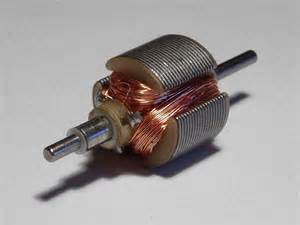The first AC motor was originally developed in 1832 by a
Frenchman named Hippolyte Pixii (AC Motor, Wikipedia).
This was a follow up to the discovery by Michael Faraday in 1831
that a changing magnetic field could create current. The way
an AC motor works is when it is connected to an electric source,
the electrons moving through the wires create a magnetic field
which causes the rotor to spin. This spinning in turn
creates a torque that is used to power certain objects. The
speed of an AC motor is usually determined by the frequency of the
AC power supply, and represented by the equation: Ns = 120F/p,
where Ns is the Synchronous speed, F is the frequency of the AC
power source, and p is the number of poles per phase winding (AC
Motor, Wikipedia).


Many household items such as fans, dryers, and humidifiers
use AC motors. AC motors are
generally better at providing large amounts of power for a
longer period of time. They are also durable and
comparatively cheap. An added benefit to these motors as
opposed to gas motors is that they don't make any greenhouse
emissions.
Image Source:
http://r.search.yahoo.com/_ylt=AwrTcXiUZilVh7EAo0KjzbkF;_ylu=X3oDMTBxNG1oMmE2BHNlYwNmcC1hdHRyaWIEc2xrA3J1cmwEaXQD/RV=2/RE=1428805396/RO=11/RU=http%3a%2f%2fen.wikipedia.org%2fwiki%2fFile%3aElectric_Motor_Rotor.jpg/RK=0/RS=ZJQWzijbphekpVfpqfzj_2RQSjc-
(AC Motor image 1 right hand side)
http://r.search.yahoo.com/_ylt=AwrTcXo3ZylVsS4AbkqjzbkF;_ylu=X3oDMTBxNG1oMmE2BHNlYwNmcC1hdHRyaWIEc2xrA3J1cmwEaXQD/RV=2/RE=1428805559/RO=11/RU=http%3a%2f%2fwww.o-digital.com%2fsupplier-catalogs%2f2179%2f2188%2fElectric-Motor-3.html/RK=0/RS=jViyRy0J_7bmgGlEZcvF68SL3Fk-
(AC Motor image 2 Left hand side)

